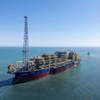Monopoly Seekers Increase Burden on Shipping -ASA
In a recent statement at a U.S. Congressional hearing, American Salvage Association (ASA) President, Todd Schauer, defended the response capabilities of the industry, and, by extension, the implementation of regulations themselves by the U.S. Coast Guard. “It has come to the attention of the American Salvage Association leadership that the resource and response capabilities of the four national salvage and marine firefighting (SMFF) resource providers have been questioned recently,” he said. “There have been false allegations made that these companies are not willing or contractually obligated to respond or somehow lack the resources to meet response requirements. This is an unabashed falsehood being propagated by commercial interests to further their own, ill-conceived program.”
Regarding the contractual obligation for an SMFF provider to respond, language in the contract asserts the resource provider is capable of, and intends to commit to, meeting the Vessel Response Plan. 33 CFR 155.4045(b) further states that the resource provider must consent to provide specified SMFF services and state these services are capable of arriving within the required response times. “All four national SMFF resource provider agreements in question meet these regulations by making the necessary statements of capability and commitment to respond within the required response times,” Schauer stated. “These contracts and consents are part of the Vessel Response Plan which is reviewed and approved by the U.S. Coast Guard. Rest assured that there will not be response delays due to contracting issues; the USCG clearly addressed this via the implementation of the SMFF regulations.”
In addition to Coast Guard contract acceptance, the SMFF response contracts have undergone the scrutiny of the marine insurance International Group of Protection and Indemnity clubs, which have also approved the contracts of all national SMFF providers as meeting the SMFF regulations. The agreements do contain statements of qualification that resources may not be immediately available, and that cascading of resources from other locations or providers may be necessary. “In fact, no SMFF resource provider, nor, for that matter any provider in any response service, can warrant 100 percent availability of resources unless multiple backup is provided,” Schauer said. “The crux of the matter is that 24-hour dedicated availability of each supporting resource in each location was never intended by the SMFF regulations. Such a commitment to have the vast myriad of SMFF support resources (tug boats, divers, derrick barges, supply boats, crew vessels, etc.) specifically dedicated for the 19 SMFF services in all U.S. ports and for all U.S coastal and offshore areas would be absolutely cost prohibitive for the salvor and its clients. This was clearly not considered by the original economic analysis of the SMFF Tank Vessel Regulations.”
Unlike pollution cleanup contractors that have focused kits of specialized equipment (boom, spill boats, and skimmers, etc.), the diversity of the 19 salvage services demands a vast network of high value support resources in addition to specialized salvage equipment and these support resources routinely perform other marine related work and services to be commercially viable. (The Federal Register Dec 31, 2008, Pg 80645, VII Regulatory Analysis, contains a detailed discussion.)
SMFF providers rely heavily on this ‘vessel of opportunity’ and ‘resource of opportunity’ system that exists throughout the ports and waterways of the United States and throughout the industrial maritime infrastructure of the U.S. This includes thousands of tugs, workboats, supply and crew boats, hundreds of derrick barges, cargo barges and a nationwide network of other marine and industrial resources including heavy equipment, commercial logistics and transportation assets, industrial service providers, divers, welders, small boat operators, etc. The U.S. commercial support fleet alone is extensive with some estimated 7,300-plus self-propelled vessels. An underpinning critical element of emergency response salvage is logistics. Salvor’s livelihoods are based on the ability of their logistics systems and networks to meet the extreme demands of the emergency salvage business. Salvors rely heavily on all air, sea and ground transport modes.
“Is there a regulatory expectation that a new logistics fleet of vessels, ground transport vehicles, and aircraft be created and dedicated 24-7 to OPA 90 response?” Schauer asked. “Any such suggestion is not only illogical, but highly impractical and not founded by any past performance issues that we are aware of. Further, it would set a very disturbing precedent and create a host of other issues if the logic were extended to the entirety of support functions required for all 19 salvage services.”
“We are aware of some derogatory comments that are being circulated by special interests regarding a very small number of recent cases,” Schauer said. “We are not believers in arm chair speculation by third parties; if there are any concerns with an actual response we recommend that the Coast Guard engage individual providers directly to address any issues or lessons learned.”
The ASA position is that the present resource provider contracting is in accordance with the SMFF regulations and was accepted by the U.S. Coast Guard and P&I Clubs. They further submit that through extensive oversight by various agencies and organizations, compliance with a number of exercise and verification programs, and, importantly, a proven track record of successful response, the nationwide SMFF providers meet the OPA 90 regulatory requirements while continuing to improve overall capability.
A key element of this compliance is the incorporation of the expansive ‘vessel of opportunity’ and ‘resource of opportunity’ system. “Any attempt to regulate the creation of a dedicated and redundant network for logistics and support resources for SMFF response would at the very least place undue financial burden on the vessel owners and/or operators, shipper and, ultimately, the consumer,” Schauer said. “U.S. salvors will continue their proud and growing legacy of professional and effective salvage response throughout U.S. waters and in support of U.S. interests abroad. We will continue to meet or exceed SMFF response standards and work closely with ship owners, regulators, and resource providers to grow and improve upon our substantial response capabilities. The ASA member salvors will continue the time-honored marine salvage tradition of “best endeavors” in responding anywhere, any time and for any incident to protect life and the environment, to keep our waterways open for commerce, and to save valuable ships and cargo.”
Schauer said, “Every vessel owner should take note of the actions of a small group aggressively lobbying Congress and criticizing the U.S. Coast Guard in an attempt to establish a monopoly market for themselves. By attempting to exclude existing fleets of tugs, supply boats, crew boats and other work boats from SMFF planning requirements, the group is promoting a precedent that will require an entirely new system of dedicated SMFF vessels and resources; at an overwhelming cost burden for vessel owners.”












